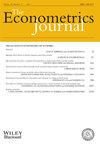Estimation of Large Covariance Matrices with Mixed Factor Structures
IF 7
4区 经济学
Q1 ECONOMICS
引用次数: 0
Abstract
Abstract We extend the Principal Orthogonal complEment Thresholding (POET) framework by Fan, J., Y. Liao, M. Mincheva (2013) to estimate large covariance matrices with a “mixed” structure of observable and unobservable strong/weak factors, and we call this method the extended POET (ePOET). Especially, the weak factor structure allows the existence of much slowly divergent eigenvalues of the covariance matrix that are frequently observed in real data. Under some mild conditions, we derive the uniform consistency of the proposed estimator for the cases with or without observable factors. Furthermore, several simulation studies show that the ePOET achieves good finite-sample performance regardless of data with strong, weak, or mixed factors structure. Finally, we conduct empirical studies to present the practical usefulness of the ePOET.混合因子结构大协方差矩阵的估计
本文扩展了Fan, J., Y. Liao, M. Mincheva(2013)的Principal Orthogonal补体阈值(POET)框架,以估计具有可观察和不可观察强/弱因子“混合”结构的大协方差矩阵,并将该方法称为扩展POET (ePOET)。特别是,弱因子结构允许协方差矩阵的特征值存在非常缓慢的发散,这在实际数据中经常观察到。在一些温和的条件下,我们得到了在有或没有可观测因子的情况下所提出的估计量的一致相合性。此外,一些仿真研究表明,无论数据具有强、弱或混合因素结构,ePOET都能获得良好的有限样本性能。最后,我们进行了实证研究,以展示ePOET的实际用途。
本文章由计算机程序翻译,如有差异,请以英文原文为准。
求助全文
约1分钟内获得全文
求助全文
来源期刊

Econometrics Journal
管理科学-数学跨学科应用
CiteScore
4.20
自引率
5.30%
发文量
25
审稿时长
>12 weeks
期刊介绍:
The Econometrics Journal was established in 1998 by the Royal Economic Society with the aim of creating a top international field journal for the publication of econometric research with a standard of intellectual rigour and academic standing similar to those of the pre-existing top field journals in econometrics. The Econometrics Journal is committed to publishing first-class papers in macro-, micro- and financial econometrics. It is a general journal for econometric research open to all areas of econometrics, whether applied, computational, methodological or theoretical contributions.
 求助内容:
求助内容: 应助结果提醒方式:
应助结果提醒方式:


